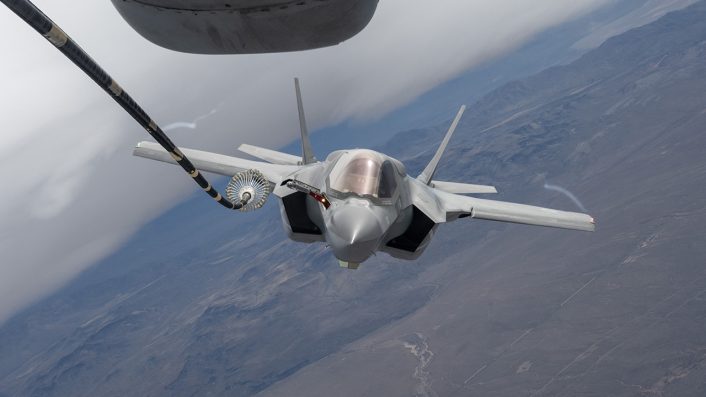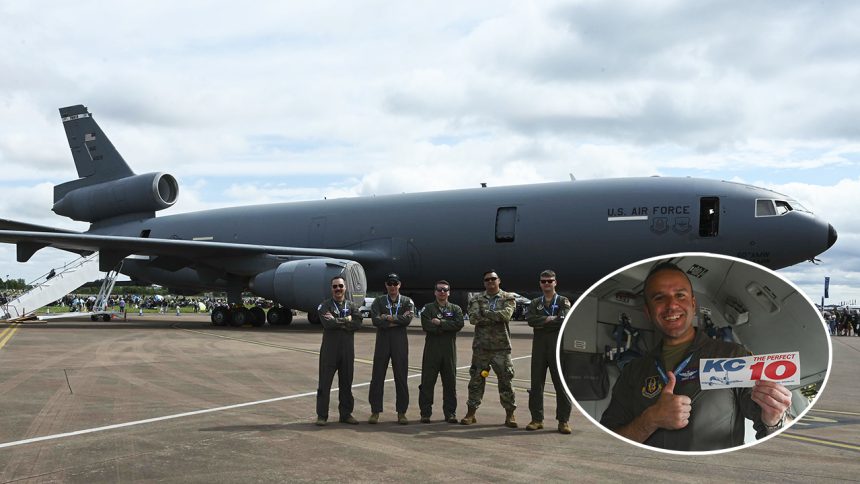Crews of the U.S. Air Force’s KC-10 Extender fleet attended the Royal International Air Tattoo at RAF Fairford to show off their aircraft to British crowds one final time before the type’s upcoming retirement.
The McDonnell Douglas KC-10 Extender, based on the McDonnell Douglas DC-10 airliner, has been in service with the U.S. Air Force since 1981. Sixty airframes were purchased in an effort to supplement the force’s large KC-135 Stratotanker fleet.
A widebody aircraft, the KC-10 offered a significantly greater fuel and cargo payload than the KC-135, and was also designed with an integrated hose and drogue refueling system, alongside a refueling boom, that was compatible with U.S. Navy, Marine Corps and many allied aircraft. KC-10s were additionally designed with the capability to themselves be refueled in the air, a feature only present on a handful of specially modified KC-135RTs.
While newer than the KC-135, the KC-10 fleet’s more limited numbers combined with the increasing rarity of the DC-10 type in service with either civilian or military operators make it an easier option for retirement than the Stratotanker. With the KC-46 Pegasus coming online following a protracted entry to service, the KC-10’s position as a larger, widebody tanker, with built in hose and drogue compatibility, is no longer unique.
KC-10A leaving #RIAT for the final time as RCH079, the same frame 86-0031 that left Prestwick today as ROMA64. Take-off here: https://t.co/J2wFyWjuvi pic.twitter.com/HXTV1pLwcd
— Saint1 (@Saint1Mil) August 18, 2024
The U.S. Air Force plans to retire the KC-10 by Sept. 30, 2024. Reflecting this, the fleet is now down into the low single figures, with only Travis Air Force Base in California still operating the type. Before the type was ordered into an early retirement, the Air Force had signaled an intent to operate KC-10s up to and possibly beyond 2043.
While they have never been permanently based in the country, KC-10s have spent a significant amount of time in the UK over their lifetimes. The first example visited the UK in May 1981, only two months after entering into USAF service. A significant deployment followed in 1986, when fifteen KC-10s arrived at RAF Mildenhall and flew long range sorties supporting a strike package of twenty four F-111 Aardvarks and five EF-111 Ravens on a 6,400 mile round trip mission to Libya, codenamed Operation El Dorado Canyon.
Further deployments would follow, supporting many long range fighter deployments known as Coronets as well as forward basing for conflicts in the Eastern European and Middle Eastern theatres.

Speaking to the British Forces Broadcasting Service’s Forces News, Major Christian Rotter of the 79th Air Refueling Squadron remarked upon his affection for the aircraft type: “I love it. I’ve been flying this aircraft for 10 years”. He noted “My record flight is 16.7 hours, so it can pretty much get you anywhere in the world non-stop.”. The crew emphasized the importance of the versatile capabilities that the KC-10 has brought to the USAF throughout its career.
The KC-10 flew its final sortie in a combat deployment in October 2023, with the last airframe forward deployed to CENTCOM departing Prince Sultan Air Base in Saudi Arabia on Oct. 5 of that year. In early 2024, the 9th Aerial Refueling Squadron undertook a farewell tour with KC-10 84-0191, departing Travis AFB and travelling to Hickam AFB, Hawaii, before venturing to New Zealand and Australia. The aircraft then flew via Diego Garcia to Europe, stopping at Sigonella in Italy, Ramstein in Germany and Keflavik in Iceland, returning to the United States via Joint Base McGuire-Dix-Lakehurst.
A final swan song
While the trip to RIAT was the official UK farewell for the KC-10, operational requirements have meant it was not actually the type’s final time on UK soil. On Aug. 9, KC-10 86-0031 landed at RAF Mildenhall as BORA 11 before departing again on Aug. 11 to support a flight of four USAF F-16s returning from refit work in Belgium.
Then, on Aug. 17, KC-10 86-0031 made yet another trip to the UK, landing at Glasgow Prestwick Airport as ROMA 64. The airframe had supported another Coronet mission, delivering F-16s to Bahrain, and stopped overnight at Prestwick on the return leg from Al Udeid, Qatar. ACARS messages between the crew and operations staff for the leg between Moron Air Base and Al Udeid noted the mission as a historic flight, and this could well turn out to be the KC-10’s final Coronet mission as well as its final visit to not only the UK, but also Spain and the Middle East.
We thought the @airtattoo was our last chance to the see the mighty KC-10A Extender. Delighted to catch ROMA64 86-0031 from @Travis60AMW at #PrestwickAirport this morning heading back to the USA before retiring next month #AvGeek #RadioGeek #MilMonWorld #NKAWTG pic.twitter.com/PQkrbqrLQr
— Military Monitoring World (@MilMonWorld) August 18, 2024
Gold-41 on the move today so spotters in England may have one last opportunity to catch a KC-10A. No indication where it will land so far. Yesterday’s ACARS messages hinted that the flight was a “historic” one so we may be seeing the last Coronet mission for a KC-10 and… https://t.co/Dhy7ridN10 pic.twitter.com/tEFpHBKS48
— MeNMyRC (@MeNMyRC1) August 17, 2024
Out with the old, in with the new
The KC-46 Pegasus is gradually assuming more taskings with the U.S. Air Force, but is still suffering from several notable issues. An improved visual system for the aircraft’s boom operators (who, unlike KC-135 and KC-10 operators, have no physical window through which to view receiving aircraft), is expected behind schedule in 2026. The Remote Vision System or RVS 2.0 will add color displays alongside other enhancements. Crews had reported issues with depth perception while using the black and white only displays used by the current system. The Air Force is also still awaiting a fix for an issue which has restricted the KC-46’s ability to refuel the A-10 Thunderbolt II.
Italy recently announced a reversal of their plans to supplement the Italian Air Force’s KC-767 tankers with the still 767 based but more modern KC-46, as well as commence an upgrade program for the air arm’s existing aircraft. No reason was given for this decision aside from ‘changed and unforeseen needs’. Issues with the KC-46’s boom led to a suspension of deliveries to the USAF in early 2024.
Problems with the KC-46 have certainly not dissuaded USAF planners from turning their attention to future plans, moving beyond the KC-135 and KC-46 and instead looking to next generation designs that could feature stealth technology. A third interim design may be procured in the shorter term under the KC-Y ‘bridge tanker’ program to ensure the U.S. military has sufficient numbers of available tankers for their worldwide operations as the fleet is recapitalized. This could be a version of the KC-46, or another design, though leading competitor Lockheed Martin has indicated that they do not currently have an interest in bidding for this contract.
Under current plans, the U.S. Air Force intends to operate a fleet of 179 KC-46s alongside their current fleet of around 377 KC-135s. Israel and Japan are the only other nations who have ordered the KC-46, with several others having instead decided to procure the more mature Airbus A330 MRTT. Notably the A330 MRTT, which has been in active service with several air forces since 2011, was initially the winner of the USAF KC-X tanker competition. The Air Force had placed an order for 179 aircraft, designated KC-45, but the decision was protested by Boeing. A repeat competition saw Northrop Grumman withdraw their joint bid with Airbus, awarding the KC-46 as the new winner.










